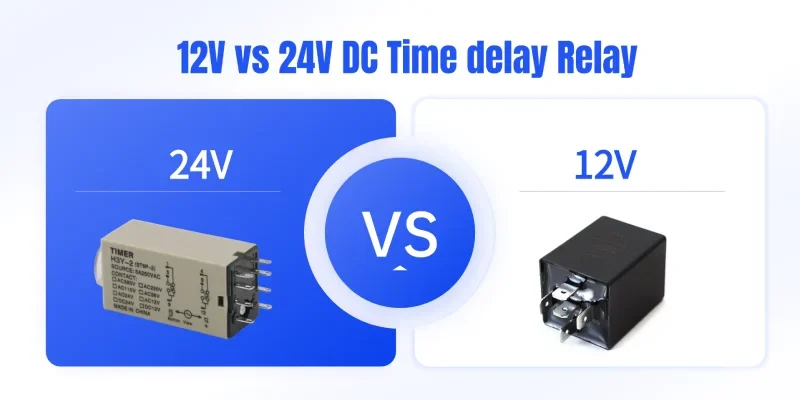Przekaźniki opóźniające są niezbędnymi komponentami w systemach elektrycznych, a warianty 12 V DC i 24 V DC oferują wyraźne zalety dla różnych zastosowań. Podczas gdy oba typy wykonują podobne funkcje czasowe, ich specyfikacje napięciowe sprawiają, że nadają się do różnych środowisk, od systemów samochodowych po automatykę przemysłową.
Działanie przekaźnika opóźniającego
Przekaźniki opóźniające działają na precyzyjnym mechanizmie czasowym, który kontroluje aktywację lub dezaktywację ich styków. Gdy sygnał wejściowy zostanie odebrany, wewnętrzny obwód czasowy przekaźnika zostaje wyzwolony, inicjując odliczanie przez wstępnie ustawiony okres opóźnienia. W tym czasie przekaźnik pozostaje w stanie początkowym. Po upływie opóźnienia styki zmieniają stan, zamykając się, aby umożliwić przepływ prądu, lub otwierając się, aby go przerwać.
Mechanizm czasowy może być elektroniczny, wykorzystujący kondensatory, rezystory i mikrokontrolery, lub elektromechaniczny, wykorzystujący mechanizmy zegarowe lub silniki. Nowoczesne przekaźniki opóźniające często zawierają komponenty półprzewodnikowe, co pozwala na kompaktowe konstrukcje i integrację z różnymi panelami sterowania. Zasada ta umożliwia precyzyjną kontrolę obwodów elektrycznych, dzięki czemu przekaźniki opóźniające są nieocenione w zastosowaniach, w których określone sekwencje czasowe mają kluczowe znaczenie dla bezpieczeństwa, wydajności lub kontroli procesu.
Dowiedz się więcej : Pełny przewodnik po przekaźnikach czasowych
Specyfikacje napięcia 12 V i 24 V
Podstawowa różnica między przekaźnikami 12 V i 24 V DC polega na ich wymaganiach dotyczących napięcia roboczego. Przekaźniki 12 V są powszechnie stosowane w zastosowaniach motoryzacyjnych, małych urządzeniach elektronicznych i systemach niskonapięciowych, w których bezpieczeństwo lub zgodność z istniejącymi konfiguracjami ma kluczowe znaczenie. Natomiast przekaźniki 24 V są zazwyczaj stosowane w zastosowaniach przemysłowych i komercyjnych, takich jak systemy automatyki, sterowanie HVAC i większe instalacje elektryczne. Wyższe napięcie przekaźników 24 V ogólnie zapewnia lepszą wydajność pod względem obsługi obciążenia i wydajności, dzięki czemu są one bardziej odpowiednie do operacji na większą skalę.
Różnice funkcjonalne w przekaźnikach
Chociaż przekaźniki czasowe 12 V i 24 V DC służą do sterowania obwodami elektrycznymi z opóźnieniami czasowymi w podobny sposób, wykazują pewne różnice funkcjonalne:
- Udźwig: Przekaźniki 24 V zazwyczaj wytrzymują większe obciążenia w porównaniu do przekaźników 12 V, przez co lepiej nadają się do zastosowań przemysłowych o większym zapotrzebowaniu na energię.
- Zakres czasowy: Oba typy oferują regulowane zakresy czasowe, ale konkretne modele mogą się różnić. Niektóre przekaźniki umożliwiają opóźnienia od milisekund do godzin, w zależności od ich konstrukcji i przeznaczenia.
- Mechanizm przełączający: Niektóre modele, takie jak TZT DC 12V 24V Dual MOS LED Digital Time Delay Relay, wykorzystują podwójny napęd równoległy MOS w celu uzyskania niższej rezystancji i wyższej wydajności prądowej, oferując lepszą wydajność w porównaniu z tradycyjnymi przekaźnikami elektromagnetycznymi.
- Opcje konfiguracji: Zaawansowane modele mogą oferować wiele funkcji i programowalnych cech. Na przykład niektóre przekaźniki pozwalają użytkownikom na ustawienie różnych zakresów czasu WŁ. i WYŁ., zapewniając większą elastyczność w sterowaniu czasem.
Kontekst zastosowania i przydatność
Wybierając pomiędzy przekaźnikami 12 V i 24 V z opóźnieniem czasowym, należy wziąć pod uwagę kilka czynników, aby zapewnić optymalną wydajność systemu. Wybór zależy od dostępnego zasilania, kompatybilności systemu i konkretnych wymagań aplikacji. Na przykład przekaźnik 24 V w systemie 12 V wymagałby dodatkowego sprzętu do konwersji, co potencjalnie zwiększałoby złożoność i koszt. Względy bezpieczeństwa również odgrywają rolę, ponieważ systemy o wyższym napięciu, takie jak 24 V, mogą być bardziej wydajne na dłuższych dystansach ze względu na niższe wymagania prądowe dla tego samego poziomu mocy, co zmniejsza utratę ciepła w przewodach. Niektóre przekaźniki, takie jak regulowany przekaźnik czasowy z opóźnieniem od 12 Volt Planet, oferują wszechstronność, obsługując zarówno operacje 12 V, jak i 24 V, umożliwiając konfiguracje opóźnienia WŁ. lub WYŁ. z opóźnieniami ustawianymi przez użytkownika w zakresie od 0,5 sekundy do 6 godzin.
Zasilanie i wydajność
Systemy o wyższym napięciu, takie jak te wykorzystujące przekaźniki 24 V, oferują lepszą wydajność na dłuższych dystansach dzięki zmniejszonym wymaganiom prądowym przy tym samym poziomie mocy. Ta cecha skutkuje mniejszą utratą ciepła w przewodach i zwiększoną ogólną wydajnością systemu. Wybierając przekaźnik opóźniający, kluczowe jest uwzględnienie dostępnego zasilania i zapewnienie zgodności z innymi komponentami systemu. Niektóre wszechstronne modele, takie jak regulowany przekaźnik opóźniający firmy 12 Volt Planet, obsługują zarówno operacje 12 V, jak i 24 V, zapewniając elastyczność dla różnych zastosowań z opóźnieniami ustawianymi przez użytkownika w zakresie od 0,5 sekundy do 6 godzin.
Przekaźniki DC i AC
Przekaźniki opóźniające DC i AC pełnią podobne funkcje, ale są przeznaczone do różnych systemów zasilania i zastosowań. Przekaźniki opóźniające DC są zazwyczaj stosowane w systemach niskonapięciowych i oferują zalety w niektórych scenariuszach:
- Kompatybilność: Przekaźniki prądu stałego są powszechnie stosowane w systemach samochodowych, morskich i solarnych, gdzie dostępny jest prąd stały.
- Wydajność: Przekaźniki prądu stałego zużywają zazwyczaj mniej energii i wytwarzają mniej ciepła w porównaniu do przekaźników prądu przemiennego.
- Szybsza reakcja: Przekaźniki prądu stałego często charakteryzują się szybszym czasem przełączania ze względu na brak punktów przejścia przez zero w prądzie stałym.
Z drugiej strony przekaźniki czasowe prądu przemiennego są bardziej powszechne w zastosowaniach przemysłowych i domowych:
- Obsługa wyższego napięcia: Przekaźniki prądu przemiennego są zaprojektowane do pracy ze standardowym napięciem sieciowym, zwykle 120 V lub 240 V prądu przemiennego.
- Odporność na zakłócenia: Przekaźniki prądu przemiennego są mniej wrażliwe na zakłócenia elektryczne, dzięki czemu nadają się do stosowania w środowiskach o silnych zakłóceniach elektromagnetycznych.
- Łuki samogasnące: Punkty przejścia przez zero prądu przemiennego pomagają gasić łuki elektryczne podczas przełączania, co potencjalnie wydłuża żywotność przekaźnika.
Przy wyborze pomiędzy przekaźnikami czasowymi prądu stałego i przemiennego, należy koniecznie wziąć pod uwagę źródło zasilania, wymagania zastosowania i czynniki środowiskowe, aby zapewnić optymalną wydajność i kompatybilność z istniejącym systemem elektrycznym.
Czy przekaźnik 24 V będzie działał przy napięciu 12 V?
Chociaż przekaźnik 24 V może technicznie działać przy 12 V w niektórych przypadkach, generalnie nie jest zalecany do niezawodnego i bezpiecznego długotrwałego użytkowania. Podstawowym problemem jest to, że zasilanie 12 V może nie zapewniać wystarczającej mocy, aby w pełni zasilić cewkę przekaźnika, co prowadzi do niespójnej wydajności lub braku przełączania. Niektóre przekaźniki 24 V mogą częściowo aktywować się przy napięciu 12 V, ale może to spowodować przegrzanie i przedwczesne uszkodzenie cewki.
W przypadku zastosowań wymagających kompatybilności zarówno z systemami 12 V, jak i 24 V, należy rozważyć następujące alternatywy:
- Użyj przekaźnika wielonapięciowego zaprojektowanego do pracy zarówno z wejściami 12 V, jak i 24 V.
- Zastosuj przetwornik napięcia, aby zwiększyć napięcie cewki przekaźnika z 12 V do 24 V.
- Wykorzystaj obwód PWM (modulacja szerokości impulsu) do sterowania przekaźnikiem 24 V ze źródła 12 V
- Wybierz przekaźnik 12 V ze stykami przystosowanymi do pracy przy napięciu 24 V
Przy wyborze rozwiązania dla układów o mieszanym napięciu należy zawsze zapoznać się z kartą katalogową przekaźnika i wziąć pod uwagę konkretne wymagania konkretnego zastosowania.
Rozwiązania dla systemów o mieszanym napięciu
W przypadku zastosowań wymagających przekaźników w układach o mieszanym napięciu dostępnych jest kilka rozwiązań:
- Użyj przekaźnika z cewką 12 V i stykami przystosowanymi do pracy przy napięciu 24 V, co zapewni prawidłową aktywację i możliwość przełączania..
- Użyj przetwornika napięcia lub osobnego zasilacza, aby zapewnić prawidłowe napięcie cewki 24 V, gdy dostępne jest tylko 12 V.
- Rozważ zastosowanie specjalistycznych przekaźników przeznaczonych do pracy w trybie dwunapięciowym, które mogą pracować zarówno w systemach 12 V, jak i 24 V..
Wybierając rozwiązanie, zawsze należy kierować się bezpieczeństwem i niezawodnością, sprawdzając specyfikacje w karcie katalogowej przekaźnika i biorąc pod uwagę szczególne wymagania konkretnego zastosowania.


